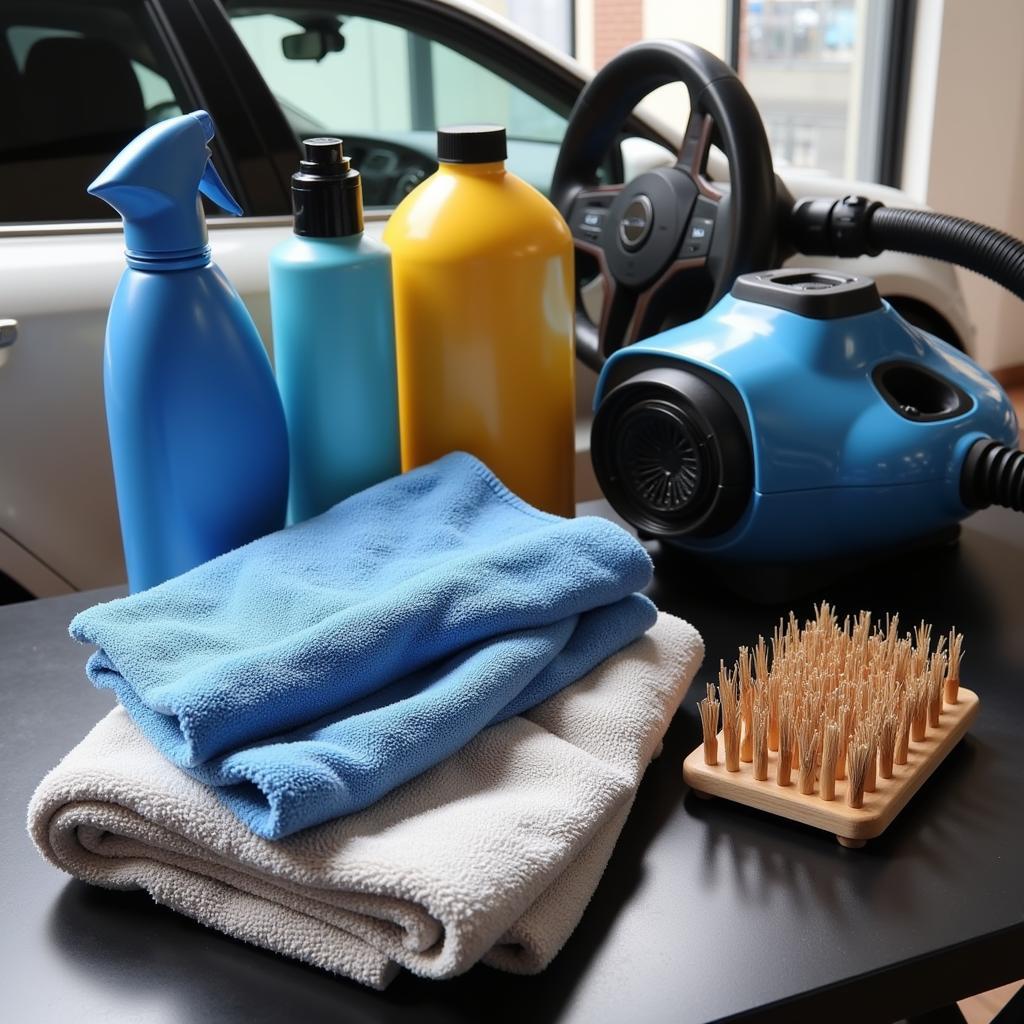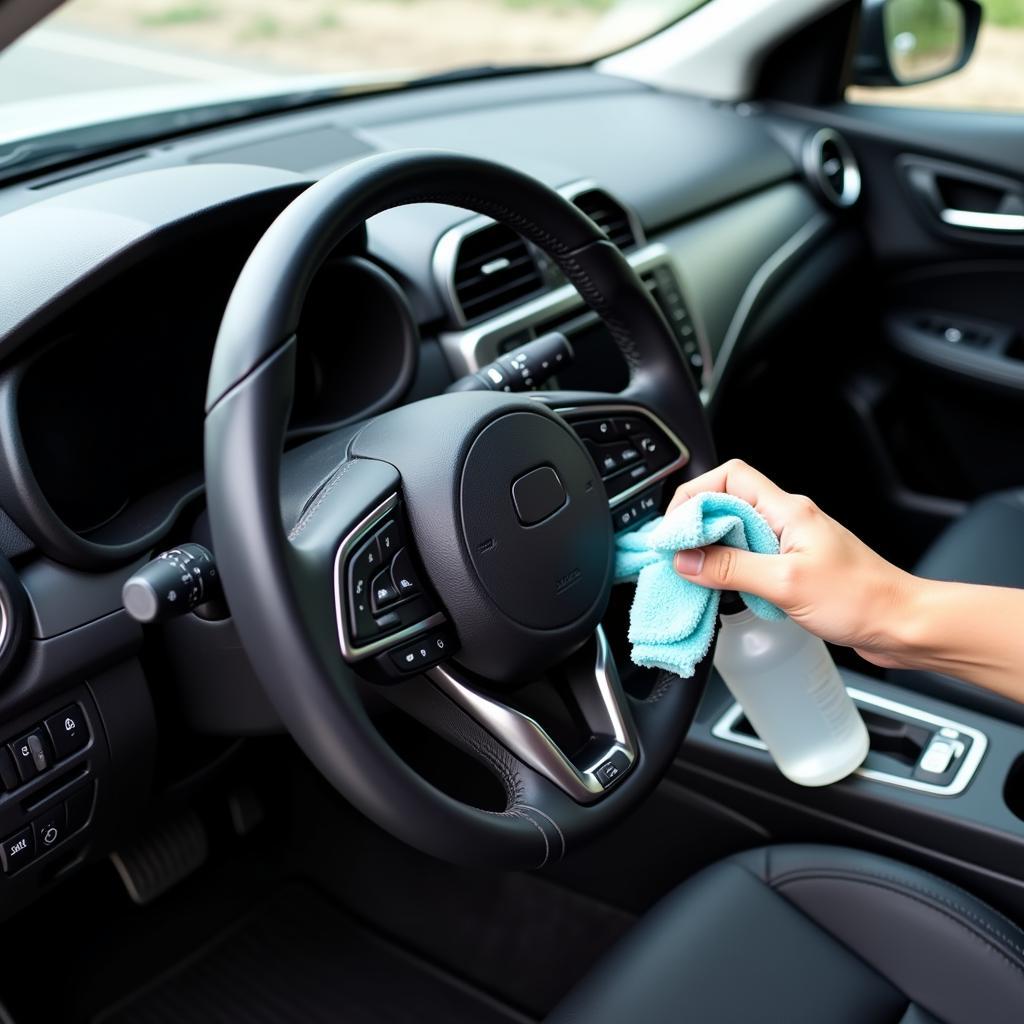Leasing a car is a fantastic way to enjoy a new set of wheels without the commitment of buying. But just because it’s not your car forever, doesn’t mean you shouldn’t treat it with care, especially when it comes time for its return. Knowing How To Detail Your Leased Car can not only save you from potential lease-end fees but also contributes to a more enjoyable driving experience overall.
 Leased Car Detailing Supplies
Leased Car Detailing Supplies
Why Detailing Your Leased Car Matters
You might wonder, “Why bother with detailing if I’m just returning the car?” Well, lease agreements often come with strict guidelines regarding the car’s condition upon return. Excessive wear and tear, both inside and out, can lead to hefty charges. By understanding how to detail your leased car properly, you can avoid those unexpected expenses and ensure a smooth lease return process.
More than just avoiding fees, detailing your leased car offers benefits like:
- Preserving Resale Value: While you won’t be selling the car, the leasing company will. A well-maintained car fetches a higher price, which indirectly benefits you in the long run.
- Enhanced Driving Experience: A clean and fresh car is simply more enjoyable to drive.
- Protecting Your Health: Regular cleaning eliminates dust, allergens, and bacteria, contributing to a healthier cabin environment.
A Step-by-Step Guide to Detailing Your Leased Car
Detailing might seem daunting, but it’s entirely manageable when broken down into steps. Here’s how to detail your leased car like a pro:
1. Interior Detailing
- Declutter and Empty the Car: Start by removing all personal belongings, trash, and unnecessary items from the car.
- Thorough Vacuuming: Vacuum the carpets, floor mats, seats, and even hard-to-reach areas like under the seats and between the center console and seats.
- Clean and Condition the Surfaces: Use a suitable interior cleaner to wipe down the dashboard, steering wheel, door panels, and other interior surfaces. Follow up with a protectant designed for your car’s interior materials.
- Clean the Windows and Mirrors: Employ a glass cleaner and a microfiber cloth to achieve a streak-free shine on all windows and mirrors.
- Shampoo the Carpets and Floor Mats: If your car’s carpets or floor mats are heavily soiled, consider using a carpet shampoo or taking them to a professional cleaner.
 Car Interior Cleaning in Progress
Car Interior Cleaning in Progress
2. Exterior Detailing
- Pre-Wash and Rinse: Begin with a thorough rinse to remove loose dirt and debris. Use a pre-wash solution if necessary to loosen more stubborn grime.
- Two-Bucket Wash Method: Wash your car using the two-bucket method: one bucket with soapy water and one with clean water for rinsing your wash mitt. This helps prevent swirl marks and scratches.
- Dry with a Microfiber Towel: Dry the car immediately after washing to prevent water spots. A high-quality microfiber drying towel is essential for a scratch-free finish.
- Clay Bar Treatment: Consider using a clay bar to remove embedded contaminants like tree sap and industrial fallout. Follow up with a lubricant designed for clay bar use.
- Polish (Optional): If your car’s paint has minor scratches or swirl marks, polishing can help remove them and enhance the shine. However, if you’re unsure about polishing, it’s best left to professionals.
- Wax or Sealant: Apply a layer of wax or sealant to protect the paint and add gloss. Choose a product that suits your needs and preferences in terms of durability and shine.
3. Engine Bay Cleaning
While not always mandatory for lease returns, a clean engine bay demonstrates care and can positively influence the inspection.
- Safety First: Before cleaning, ensure the engine is cool and disconnect the battery’s negative terminal as a precaution.
- Degreasing: Apply a suitable engine degreaser to the dirty areas and let it sit for the recommended time.
- Agitation and Rinse: Use a brush and water to agitate the degreaser and loosen grime. Rinse thoroughly, ensuring water doesn’t enter sensitive engine components.
Should You DIY or Hire a Professional?
You’ve now got a good understanding of how to detail your leased car. The decision to DIY or hire a professional detailer depends on your comfort level, time constraints, and budget. DIY detailing can be satisfying and cost-effective, but professional detailers have the expertise and equipment to achieve a higher level of cleanliness and protection.
Maintaining Your Detailed Car
Once you’ve detailed your leased car, consistent upkeep will help preserve its condition:
- Regular Washing: Wash your car every two weeks, or more frequently if exposed to harsh conditions.
- Quick Interior Clean-Ups: Regularly remove trash and wipe down surfaces to prevent dirt buildup.
- Touch-Up Products: Keep touch-up products like quick detailer and interior wipes handy for addressing minor spills and dust.
By following these tips and investing a little time and effort, you can return your leased car in excellent condition, avoid unnecessary charges, and take pride in a job well done. Should you have your car detailed before selling it? Absolutely!
Frequently Asked Questions (FAQs)
Is it worth paying for a professional detail on a leased car?
The decision to hire a professional or detail your leased car yourself depends on various factors such as your budget, available time, and the car’s condition. Professional detailing can be more expensive but offers a higher level of cleanliness and may be worth considering, especially closer to your lease return date.
What happens if I return my leased car dirty?
Returning a leased car with excessive dirt or grime may result in cleaning fees, as stipulated in your lease agreement. These fees can vary depending on the leasing company and the extent of cleaning required.
How often should I wash my leased car?
It’s generally recommended to wash your leased car every two weeks or more frequently if exposed to harsh elements like dirt, salt, or bird droppings. Regular washing helps preserve the car’s paint and prevents dirt buildup.
For those looking to delve further into the world of car care, our comprehensive guide on how to start detailing cars is an excellent resource.

Leave a Reply